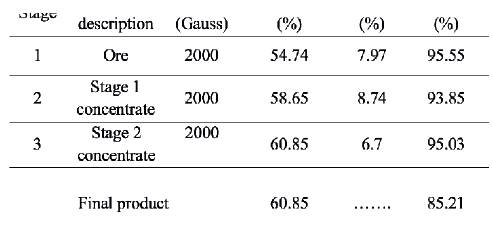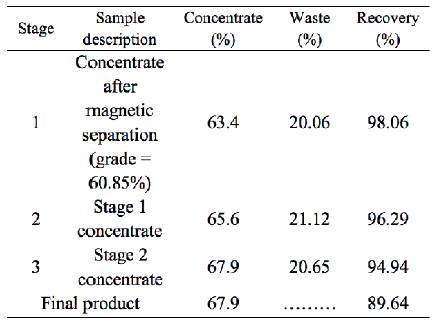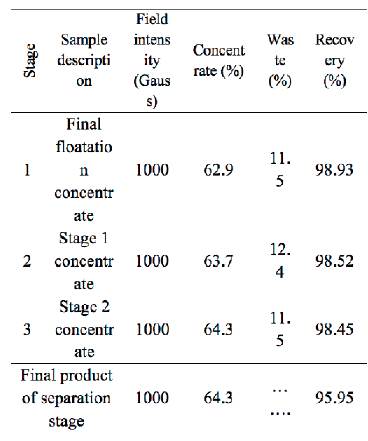Introduction
Methods available for upgrading iron or aree physical (magnetic), physicochemical (floatation) or chemical methods, amongst which the physical methods are the most cost effective (Rezaei, 1999). When the particle size of the impurities is large, upgrading is possible in larger dimensions and the cost will decrease. Rock upgradation ability and upgrading costs are important factors in the evaluation of iron ore (Cohen, 1986). The type of processing and its stages depend on the ore and its complexity. In general, magnetite iron ore upgrades initially include two or three stages of crushing and dry magnetic separation (Svoboda and Fujita, 2003).
For mechanical floatation to function effectively the energy should be sufficient to meet the requirements of floatation; therefore, optimal energy use is critical. Some of the energy consumed is transmitted across the cell as kinetic energy available in the vortices of various sizes, but most of it is lost through micro-interactions between the water, air and solid phases (Schubert, 1999; Shahbazi et al., 2015; Schubert and Bischofberger, 1978; Ahmed and Jameson, 1985; Deglon et al., 1998; Pyke et al., 2003; Newell and Grano, 2006; Amini et al., 2013). After grinding to release the minerals, the valuable minerals are separated from the gangue. Floatation is a commonly used separation process (Chau, 2009; Vaqar, 1997).
Magnetic separation is a physical and low-cost upgradation method for minerals having magnetic properties. The use of flotation depends on the surface characteristics of the minerals. Because rock is composed of different minerals, different methods must be employed to process them according to their economic viability and in terms of the percentage of recovery and improvement in the grade. The current study was undertaken to determine the optimal state of the parameters affecting floatation and magnetic separation and the sequence of use of each method is investigated.
Research method
The study area is the Band-e Narges iron ore mine located in northern Isfahan province about 70 km northeast of the city of Badrud. For analysis of the use of floatation and magnetic separation, the samples were crushed by jaw, cylindrical and conical crushers into dimensions of less than 2 mm. The product was then sieved with 18, 30, 50, 80, 100, 120, 150, 170, 200 and 230 mesh. Representative samples were collected from each sieve class to make a smooth section. Analysis of the smooth sections allowed determination of the degrees of freedom (DoF) and the dispersion of mineral particles. Testing was then conducted for different sizes and intensities to determine the parameters affecting magnetic and floatation separation. After determining the optimum parameters and obtaining concentrates using each method, the floatation concentrate was further processed by magnetic separation and the primary magnetic separation concentrate was further processed by floatation and the results were compared in terms of grade, recovery and sulfur content.
Discussion degree of freedom
Economic recovery of valuable minerals depends on several factors. Grind ability is the most important characteristics determining the grinding mechanism, which includes crushing and smelting. One goal of these processes is the release of valuable minerals from waste material in the largest possible particle size. For present study, the samples were crushed using jaw and conical crushers to dimensions of less than 2 mm and were then run through mesh of different sizes (18, 30, 50, 80, 100, 120, 150, 170, 200, and 230). From each size of sieve, samples were collected to determine the DoF and prepare smooth sections. Analysis of the smooth sections showed that the particles from the 120-mesh sieve class (125-150 micron) featured the required DoF of d80.
Analysis of the smooth sections showed that the magnetite from the 100 mesh at 150 micron had the highest amount of release (d80); therefore, this range of granulation was used for processing. The mineral ore must be upgraded after grinding in accordance with its mineralogical characteristics. However, in smooth sections at this range of granulation, there is contact between the magnet and disturbing minerals; thus, the processing orbit appropriate to the type and characteristics of minerals should be carefully selected. If the processing orbit is designed precisely, the cost and time of the process will be minimized at the operational stages. Because the samples tested in this study were identified to be magnetite, a magnetic separation technique was used to upgrade it as the most cost-and time-efficient method.
The magnetic properties of different materials generally depend on the amount of electrical charge and the magnetic torque (spin) of the electrons. The motion of an electron cloud around an atomic nucleus in the form of opposing orbitals creates a magnetic dipole torque. The sum of the magnetic torque generated by the spins when moving around the nucleus and the magnetic dipole torque caused by an external magnetic field gives the induction dipole torque (Skoog et al., 2013).
Davis tube testing was used to determine the optimal DoF with the highest grade at the best field intensity. It was concluded that the optimal DoF for this ore occurred at a mesh size of+150, although better grades of fractions were produced at +200 and +230. These latter sizes required more grinding and more expense although the grades obtained at +150, +200 and +230 did not differ significantly. To reduce the cost of grinding and in accordance with the results of Davis tube testing, the optimum DoF for the ore was chosen to be that for the +150 mesh.
Dry magnetic separation tests
Particles with the dimensions of 0 to 150 micron produced the highest DoF and particles with 1000 to 2000 micron in size with an intensity of 2000 Gauss had the highest percentage of recovery. The difference in recovery was not very high for these two granulation ranges. In terms of grade, the grade of the particles 0 to 150 micron in size was significantly higher for those 1000 to 2000 micron in size; thus, the optimal size and field intensity were selected to be 0 to 150 micron and 2000 Gauss, respectively.
The grade of magnetite considered suitable for the industry is more than 60%. After one stage of magnetic separation, a grade of 54.74% was obtained with particles of 0 to 150 micron in size; thus, more than one stage of magnetic separation was required to reach the appropriate grade for the industry. Because the optimal dimensions were 0 to 150 micron and optimal magnetic field intensity was 2000 Gauss, further other magnetic separation was carried out for these dimensions and field intensity. In order to increase the grade, the concentrate obtained from the magnetic separation of particles 0 to 150 micron in size with a magnetic field intensity of2000 Gauss was run through two more magnetic separation stages. The results are listed in Table 1.
After three stages of magnetic separation at a 2000-Gauss field intensity on particles of 0-150 micron, a product with a grade of 60.85% and a recovery of 85.21% was obtained that is usable in the industry. The sulfur content of this product was 1.08%, so chemical methods such as floatation had to be used to reduce the sulfur content.
Use of floatation on magnetic separation concentrate
Since after three stages of magnetic separation, the sulfur content was 1.08%, the concentrate was subjecting to a next grounding with a mill to reach to gain size of less than 74 micron. The flotation was carried out in three stages to reach a concentrate with an iron grade of 67.9%, recovery of 76.39% and sulfur content of 0.48%. The results are shown in Table 2. As seen, after floatation on the magnetic separation concentrate, the amount of sulfur decreased to 0.48% while the iron content increased.
Use of magnetic separation on floatation concentrate
When the floatation parameters were optimized, five stages of floatation were performed and a product with a grade of 60.02%, a recovery of 80.41% and a sulfur content of 0.95% was obtained. The concentrate was next subjected to magnetic separation. Because floatation is performed only on particles of less than 74 micron, magnetic separation could only be performed on particles of that size. It was possible, however, to examine the intensity of the field at 1000, 1500 and 2000 Gauss. It was determined that, for a floatation concentrate of less than 74 micron in size, the highest grade was produced at 1000 Gauss; thus, three stages of magnetic separation were performed on the concentrate at 1000 Gauss. The results are shown in Table 3. After three stages of magnetic separation a product was attained with a grade of 64.3% and a final recovery of 77.15% iron and a sulfur content of 0.74% (Table 4).
Conclusion
The type and complexity of ore determines the type of processing used. In addition, factors such as the simplicity, cost-effectiveness, speed and level of environmental pollution of the various processes must be taken into account. The results of this study showed that the use of the magnetic separation method as a pre-concentration method for floatation is more suitable than using the flotation method as a pre-concentration method for magnetic separation. The following conclusions were drawn.
The most appropriate dimensions for magnetic separation are equivalent to a DOF of 150 micron, while the proper dimensions for floatation are 74 micron. This indicates that the use of magnetic separation before floatation will reduce the cost of grinding.
The optimal magnetic field intensity for magnetic separation when it is used for pre-concentration was 2000 Gauss for a particle size of up to 150 micron. When flotation was used as a pre-concentration before magnetic separation, the optimal field intensity was 1000 Gauss because the particle size was a maximum of 74 micron. This occurred because, when small particles are subjected to high field intensities, they create magnetic masses from the soft particles created. These masses trap waste and reduce the grade at high intensity; thus, the intensity of the field is reduced.
The use of floatation method as pre-concentration for magnetic separation required a total of five stages. This increases the cost of chemicals consumed, the difficulty of the process and amount of environmental pollution produced.
The use of magnetic separation before floatation for pre-concentration creates a product with a higher grade, recovery and sulfur content. The high sulfur content should be reduced by chemical methods such as floatation.
When magnetic separation is used as pre-concentration, its product has a higher grade and a lower sulfur content, which is a drawback. Although the recovery was less, its high grade and low sulfur content justifies this approach.


















